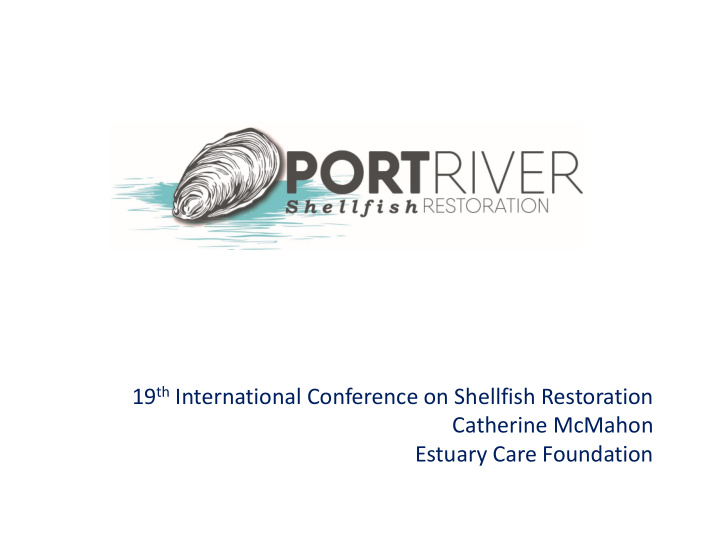



19 th International Conference on Shellfish Restoration Catherine McMahon Estuary Care Foundation
Colleagues Tony Bazeley and Helen Macilwain Port Adelaide Residents Environment Protection Group Peter Hunt and Mike Burrell Malacological Society SA
Introduction to Shellfish Restoration Shellfish reefs, a component of Living Shorelines; drawing by Peri Coleman 2015
Now: an Australian Restoration Project
Port River & Barker Inlet Estuary Aerial view photo 2008 by Gary Sauer-Thompson
Port River & Barker Inlet Estuary • Industrial area e.g. working port, power plants • Pollution into River reduced • Improved River health e.g. shellfish, seagrass • Challenges remain e.g. dredging, stormwater • Threats – vulnerable to sea level rise and storms
Shellfish in Kaurna life Yelta Bulti (Port River and Estuary region): • kakirra black river mussel • kulutunumi periwinkle • kunggurla river crawfish • kuti cockles • large oysters • blue swimmer crabs
Vision • Restoration of healthy ecosystem • Clean river & reefs attenuate wave action • Healthy environment e.g. swimming • Connected & engaged community • Encourage & support other community projects
Existing reef builders Pacific oysters and mussels in Inner Harbour, August 2017
Now: shellfish on Submarine Corp oil spill containment boom growth on boom, after 15 months in water 18 August 2016
Now: pinna reef pinna reef at Outer Harbour, January 2017
Angasi washed onto our beach
• Group commenced January 2016 • Community initiated & led • Community development approach • Sites • Involving groups & individuals • Engagement with schools • Community education
Support • Information & Advice • Community NRM Grant $5K (Envt Dept) • SEAPA – donated some baskets • Pacific Estate Oysters – donated many of our 316 Ostrea angasi • TNC – donating spat on shell & recycled shell
Our questions • Can (316) Ostrea angasi survive at our trial sites? • What spat can be recruited during the spawning seasons of mussels and Ostrea angasi ? • Can Ostrea angasi spat on shell survive at our trial sites?
Key Results • 316 angasi deployed, 6 sites in 16 baskets on 31 st May 2017 • 264 remain; some ‘lost’ and others dead • Growth initially in shell, then in weight • Spawning, spat on baskets & terracotta tiles • Ascidians & silt have caused much cleaning • angasi in baskets creating habitat
Results so far Shell growth within 2 weeks Spat transferred to basket, CYC
Grow sites
Mark, measure, weigh Working bee, 31 May 2017
and photograph
Measurements • May 31st, 2017 • Week of July 10 th – weigh & measure • Late Sept – weigh, measure & photograph • Mid Feb 2018 - weigh & measure Lots of data to analyse for individual baskets, sites and oysters overall (Honours student?)
Aver length measurement, end Sept
What we don’t want growing Oyster leech flatworm Stylochus species Ciona intestinalis Mussel drills Lepsiella paivae
What’s growing on or with our angasi Bowerbird: http://www.bowerbird.org.au/projects/11169
Engaged with three schools Portside Christian College students 26.9.17
Community Education Science Alive, August 2017
Community Education Cruising Yacht Club magazine Dec 2017 Scientific Expedition Group Dec 2017
Challenges • Tell our story publicly – when? • ‘Enforcement’ vs Engagement • Scaling up • Field trips with schools e.g. education officer
Plans for the future • Trials with spat on shell (TNC) • Substrate for our reef builders • Trial ‘reefs’ in Inner Harbour • Trials of clean recycled bagged shell, including with seagrass restoration trial
Estuary Care Foundation SA Inc Catherine McMahon estuarycare@internode.on.net 0413 578086
Recommend
More recommend